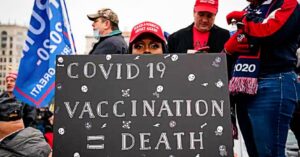President Kennedy was elected while I was a grad student at the University of Chicago. I remember being physically nauseated by his speech, and that doesn’t happen very often.
—Bernard Sanders, 1987
We’ve had two right-wing populist presidents, Jackson and Trump, but never one from the left. These are populist times, and in 2016, Bernie Sanders came surprisingly close to filling that gap. He looks unlikely to do any better in 2020, but the populist moment has not passed.
Elizabeth Warren is running quite a populist campaign but she is running as a Democrat and shows little sign of trying to overthrow the Democratic Party. Alexandria Ocasio-Cortez, however, would likely follow Sanders’ path if she gets the chance. And there’s no telling what other surprises lie in wait.
With this in mind, let’s take a look at Sanders’ 2016 campaign to see what we can learn about a left-populist takeover. Of course, populism, as explained earlier, takes many forms, so examining Sanders’ strategy cannot provide a definitive diagnosis. But a look at his strategy may still teach us some valuable lessons about left populism in America. Because Bernie Sanders says he speaks for the people—the 99%—surely it’s not possible that he would hide a one-percenter in his back office to work on campaign strategy. Well, yes, actually he would. Let me tell you about Tad Devine.
Tad Devine: The One-Percenter Strategist
Devine often makes more than a million dollars a year, double what it takes to be a one-percenter. And Sanders paid him $5 million to be his chief strategist for his one-year primary campaign in 2015−16.
So who is this guy? He’s worked for some establishment Democrats you may have heard of: Jimmy Carter, Walter Mondale, Michael Dukakis, Al Gore, and John Kerry. Sanders started working with him in the 1990s.
Then in 2006, Devine landed a new kind of client—Viktor Fedorovych Yanukovych. But of course! He’s the Ukrainian candidate who messed with their 2004 election and triggered the “Orange Revolution.” That forced a rerun, which was fair, and Yanukovych lost. Enter Paul Manafort, who hired Devine to flip the next election to Yanukovych.
Manafort?! Wasn’t he Trump’s campaign chairman from June to August 2016, the man who Donald Trump dumped for having sleazy Ukrainian connections? That’s him. He was convicted of tax and bank fraud in 2018, and as of July 2019, he was set to be released from prison at the end of 2024. And Yanukovych? He’s now in exile in Russia and wanted by Ukraine for high treason.
Back to Tad Devine: He repackaged Yanukovych and helped reelect him in 2010 by recommending an advertising campaign comprised of 75-percent attack ads—his specialty. Devine quit in 2012 after Yanukovych jailed a former rival for the presidency and built a $100-million mansion complete with a zoo and replica galleon on an artificial lake.
But four months after “quitting,” Devine wrote a strategy memo for Manafort saying, “The number of people who admit they are having difficulty feeding their family throughout Ukraine today is stunning.” His strategy memo urged Yanukovych to “signal” his concern. How touching.
The progressive magazine Mother Jones reported in 2014 that Devine’s consulting firm won a national political-consultant prize for creating “one of the most brutal attack ads you’ll ever see.” So here’s my question:
Why did Bernie Sanders hire as his chief strategist a one-percenter and attack-ad specialist who made millions working to install a dictator?
Populism: The Will of ‘the People’?
In his book, Our Revolution, Sanders twice refers to himself as a populist. Nearly everyone agrees because he divides the world into Us, “the American people,” aka the 99%, and Them, the Wall Street billionaires and their lackeys, the Democratic establishment.
Sanders also adopted another defining aspect of populism, which goes a long way towards explaining his use of Tad Devine. To be a true populist, you must believe that the people have a single, incorruptible “will” that should prevail over the immoral elite.
But “the people” never do have a single “will.” Instead, they have a lot of disagreements. So a populist movement remains chaotic until it adopts a charismatic leader who defines “the will of the people.” Pippa Norris, a leading expert on populism, explained the need for such a leader:
Even though [populism] is about popular sovereignty … in practice, what happens is the power is seen to reside in the individual leader, the charismatic leader who represents the voice of the ordinary people.
Bernie Sanders was the left’s charismatic leader in 2016, and “popular sovereignty” was seen by his followers to reside in him. Because he alone “represented the voice of the ordinary people,” he had a license to do whatever it took to make sure their will prevailed. That included appointing Tad Devine as chief strategist for his campaign.
[Image]
Sanders running for V.P. in 1904 with his lifelong hero, Eugene V. Debs
Sanders’ Plan
In our two-party system, it’s almost impossible for a third party to succeed. A million spectators cheered Teddy Roosevelt as he led 150 of his Rough Riders up Broadway after his two terms as president and a year-long African safari. Yet three years later, he gained only 27% of the popular vote running as a third-party, Bull Moose progressive populist. That was in 1912, and no one has come close to that since.
The only way for a socialist or radical populist to win the presidency is by taking over one of the major political parties, as Trump has. So that’s Sanders’ plan. He is not going to become a Democrat; he intends to turn the Democrats into a party of socialist populism. Here’s the evidence.
Not a Democrat. “Of course I am a Democrat and running for the Democratic nomination,” claimed Sanders in February 2016. He needed to seem to be a Democrat so the Party would let him run, but he needed his base to know he really was not. In March, at an MSNBC town-hall event in Ohio, when asked why he decided to run as a Democrat, he had two answers: (1) “media coverage,” and (2) “I’m not a billionaire” (he wanted to get his hands on that filthy Democratic money). The easy answer should have been, “Because I am now really a Democrat.” But he wasn’t. His website and his literature continued to list him as an independent.
On the first day of his “Unity Tour” in June 2017 with Democratic Party Chairman Tom Perez, Sanders’ supporters booed Perez. During the tour, Chris Hayes of MSNBC asked Sanders, “Do you consider yourself a Democrat?” Sanders said, “No, I am an independent.”
How could such a “let me be very honest” truth-teller justify saying he was a Democrat so he could run as one when he wasn’t? The answer is populism. He really believes he is the only true voice of the virtuous 99%, and it would be immoral for him not to make his best effort to take over the Democratic Party and implement the will of the people. This is all an integral part of a populist strategy.
Discrediting the Party. Sanders complained endlessly during the primaries about how the Democratic superdelegates were rigged against him, and how he could win the majority of elected delegates and the superdelegates would still take away his victory.
His purpose was both to delegitimize the party in the eyes of his followers and potential followers and thereby weaken it and to engineer rule changes (some of which happened) that would make the party more vulnerable to a hostile takeover. The point of superdelegates is to protect against both hostile and incompetent takeovers. It’s not a bad system because superdelegates just vote in line with the majority of elected delegates unless the party is in danger of choosing a candidate who’s too likely to lose the election.
To see that Sanders’ complaints were insincere, consider what happened next. On June 8, 2016, Clinton secured the majority of elected delegates (not counting superdelegates), and there was no longer even a slim hope for Sanders. And what did Sanders do then?
Unbelievably, Sanders spent more than a month asking the superdelegates to do for him exactly what he had previously accused them, without a shred of evidence, of plotting to do for Clinton. He asked them to overturn the will of the voters and rig the outcome for him.
Again, this was the result of a populist mindset. Populist leaders believe they speak for “the virtuous people,” so anything is justified.
Trying to defeat Trump? Sanders finally endorsed Clinton on July 12 and declared, “I intend to do everything I can to make certain she will be the next president.” It was a promise he made more than once.
By the time he made the promise, his mind was elsewhere. Two days later, he announced he was about to write the book, Our Revolution—during the crucial final months before the election. The day after that, he discussed his new super PAC, also called “Our Revolution,” with USA Today and immediately began raising money for it. Sanders did not make a single campaign appearance for Clinton until he spoke to a small group of students in New Hampshire in early September.
He was in a rush with the book because he expected Clinton to win, and he wanted to start discrediting her as soon as possible. Launching his new super PAC before the election had the same purpose.
Finally, in mid-September, he appeared on MSNBC’s Morning Joe and made a strong case that Clinton’s policies were far better than Trump’s. But when asked about Green Party candidate Jill Stein and whether he trusted “that [Clinton] will honor [the Democratic platform],” he dodged both questions. Because his principal surrogate Cornel West was vociferously backing the Green Party candidate against Clinton, these were the two most pressing questions for his followers. He never addressed either one.
By weaseling out of those questions, he gave a pass to voting for Stein, who more than tripled her vote over the previous presidential election when there was no Trump emergency. Had Sanders kept his promise about supporting Clinton at that opportune moment, he would have done more to defeat Trump than he did in all his (minor) appearances after the Democratic convention. But he knew the only way he’d have another shot at the presidency was to weaken President Clinton (hence the rush to publish his anti-Clinton book) or to let her lose.
Our Revolution. In June 2017, a leading progressive magazine, The Nation, asked Nina Turner, president of “Our Revolution,” Sanders’ 501(c)(4) dark-money super PAC: “How will Our Revolution relate to the DNC, the DCCC and the DSCC?” She replied, “I don’t think it is our job nor our obligation to fit in. It’s their job to fit in with us.”
Then the Nation asked: “And what about the Democratic Party at large? Do you see Our Revolution working to bring some unity to factions in the party?” Turner’s reply: “No, not really.” Obviously, Our Revolution is in takeover mode, and just as obviously, that’s what Sanders wants.
Conclusion
“So why don’t you join the Democratic Party, get funding and then come out as a socialist once you’re in office?” asked Catherine Hill, a young Marxist graduate student. It was 1987 and Sanders, with 14% of the vote, had just lost his race against the feminist Democratic Governor of Vermont, Madeleine Kunin. Sanders replied:
That’s the temptation, but it’s a fool’s temptation. … You don’t come out with any integrity. … The assumption is that you’re going to sucker the system—people who always vote Democratic will vote for you … The position of integrity is to declare who you are and not fool people. … You don’t change the system from within the Democratic Party.
But Sanders kept thinking and finally came up with a compromise that he must feel keeps his integrity. He’s sticking with not joining the Democratic Party. But he’s jiggered his integrity rule—now he feels it’s okay to “sucker the system” into thinking he’s a Democrat in order to get their “media coverage” (in debates) and their money. But he stays honest with his supporters about not being a Democrat. However, Chapter 23, will show that he’s misleading them about socialism.
This works well because the Democrats are either trusting or afraid of the far-left outrage culture. If they wanted, they could easily call Sanders’ bluff by requiring Democratic candidates to affirm that they are not independents—Sanders could not swallow that.
In short, a real populist leader will only join a party they control. And they will not feel compelled to be honest because their loyalty is to a higher cause—socialism, channeling “the will of the people,” or in Trump’s case, loyalty to himself.

 Ripped Apart
Ripped Apart

